AN / FSQ-7 - the most removable computer in history
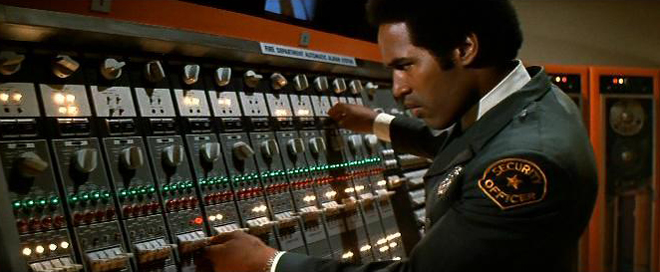
Even during the Second World War, the US Navy made an offer to the Massachusetts University of Technology about the possibility of creating a flight simulator for training bomber crews. After the success of ENIAC in 1945, it was decided to use a computer for this purpose and leave unsuccessful attempts to create an analog computer.
The project was noticeably delayed, and was completed after the end of the Second World War. It remained unclear what to do with the computer created Whirlwind - the military lost interest to the venture. He, however, was of historic importance - it was Whirlwind and the unrealized project Whirlwind II became the basis of Jay Forrester's proposal to create an air defense system.
')
The course of events accelerated the appearance of atomic weapons in the USSR and the openly strained relations between the two states. As early as December 1949, the Air Defense Committee, chaired by George Valley, recommended computerized calculations for radar stations. Valley and Forrester actually laid the foundations for the future Sage system (SAGE), the development of which cost about $ 10 billion in 1954 and included the creation of 24 command centers, including an AN / FSQ-7 computer, the size of which was never broken. .
Computers were a key component of the system. It is easy to see in hundreds of Q7 panels with their switches, buttons and flashing lights a paradise for the visual design of the movie. And that is why Q7 is the most removable computer in history. Its various parts appear in the frame today, despite the fact that it was created at the dawn of the computer era and was not used after 1983.
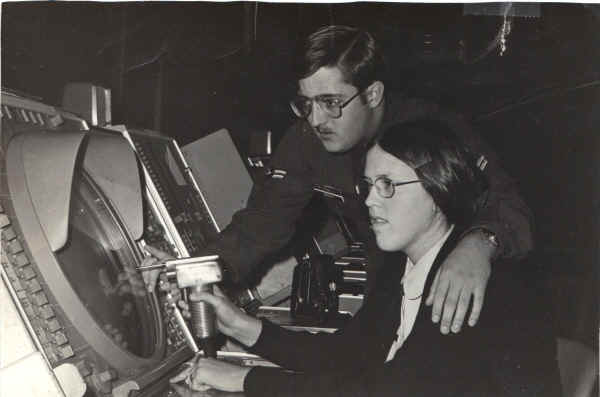
In September 1953, on the basis of Whirlwind II unrealized plans, IBM was awarded a contract to supply two prototypes. On October 28 of the same year, the Air Force Council recommends that funds be allocated from the budget of 1955 to finance the Lincoln automatic system (renamed SAGE in 1954). In 1955, the experimental SAGE sub-sector in Lexington was completed, and by October, a prototype AN / FSQ-7 called XD-1 appeared in building F, initially working without displays.
Air Force officers underwent training in Kingston, New York, in 1955. By 1959, 2,000 simulated interceptions had already been held, and the first real one took place in August 1958. Large-scale tests of the mathematical model of the ATABE (Automatic Target and Battery Evaluation) algorithm were carried out using real military radar readings that detected training violations of the defense sectors (in particular, Skyshield military exercises).
Each of the 24 monsters had 49 thousand vacuum tubes inside them (together with the external systems each item contained about 60 thousand lights), weighed 250 tons, occupied 2 thousand square meters (three floors of fortified SAGE buildings located at different points in the USA and Canada) and consumed at the peak of 3 megawatts of electricity, but the performance was high for that time - 75 thousand operations per second, which allowed to track the position of up to 300 air targets. It was possible to connect 100 consoles of operators to the computer, which were a monitor with a light gun for target extraction, a cigarette lighter and an ashtray.

To ensure the reliability of the Q7 system of RAM, control instructions, maintenance, arithmetic module, input-output control and software elements were duplicated. Thus, each of Q7 was the union of two independent computers, called Latin letters A and B. They did not function simultaneously: A did the work, while B was in standby mode and could be serviced, then they changed roles. On average, each of the computers consumed 1 megawatt of electricity.
The computer was equipped with an IBM 723 card punch, an IBM 713 punch card reader, an IBM 728 magnetic drum, exchange devices with other SAGE computers, and a light display and warning system, which consisted of several dozen consoles in different rooms.
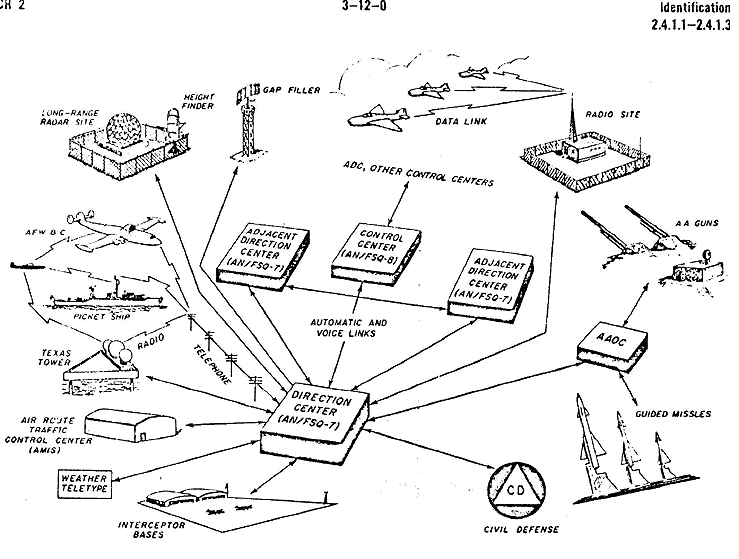
With the help of Q7, it was possible to directly launch rockets from the Bomark complex, and computer algorithms automatically controlled takeoff, flight, and the start of a supersonic jump onto the target. Later, a system for setting up autopilot piloted fighters on target guidance via the ground-to-air communication subsystem was implemented.
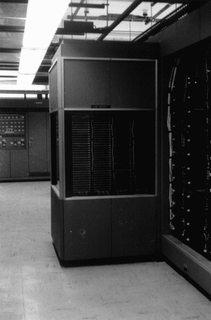 Q7 possessed Memory on magnetic cores 1 (Magnetic Core Memory No. 1) - a grid of 256 × 256 33-bit words (65.536 machine words in total, shown in the photo on the left) - and a smaller smaller module - 64 × 64, 4096 33-bit words . The memory cycle was 3.25 microseconds. His younger colleague, FSQ-8, which supplied the control centers of the SAGE system, had two modules of the size of 4096 machine words. The reason for the presence of two modules was the need to run the diagnostic mode through one of the memory modules. One of the bits of the 33-bit machine word was a parity bit.
Q7 possessed Memory on magnetic cores 1 (Magnetic Core Memory No. 1) - a grid of 256 × 256 33-bit words (65.536 machine words in total, shown in the photo on the left) - and a smaller smaller module - 64 × 64, 4096 33-bit words . The memory cycle was 3.25 microseconds. His younger colleague, FSQ-8, which supplied the control centers of the SAGE system, had two modules of the size of 4096 machine words. The reason for the presence of two modules was the need to run the diagnostic mode through one of the memory modules. One of the bits of the 33-bit machine word was a parity bit.To store the data, each of the machine words was divided into two halves, each of them contained a 15-bit number and a sign bit. Arithmetic operations were performed on both halves simultaneously. Numbers were represented as fractions from −1 to 1, in order to avoid overflow during multiplication. Setting the limits of the calculations fell on the shoulders of the programmer.
The instructions used the first half of the machine word and the bit of the second half to form addresses, which made it possible to use 17-bit memory addressing. The remainder of the second half contained the instruction. The first three bits of the second half after the bit of the mark determined the index register, the subsequent ones - the instruction class, its type and auxiliary information. Addresses were written in octal, where two bits formed a prefix.
The machines also had 12 magnetic drums: 6 for the display system, 6 for the computer itself. Each of the drums had 33 heads and several spares, which made it possible to quickly read a 33-bit word.
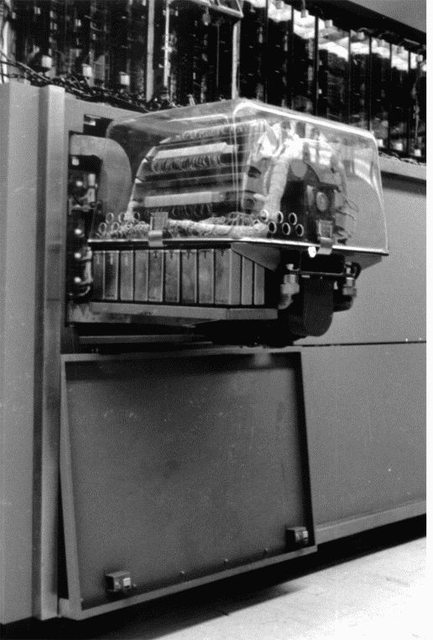
The SAGE system was fully deployed in 1963. Ironically, the network of lamp computers not only technically became outdated by this moment, but the meaning of such a system was lost due to the emergence of intercontinental ballistic missiles and a clear threat to the reality of their work in the form of Sputnik 1 (the so-called “satellite crisis”) and also a fanatical belief among the top Soviet leadership in the universality of ballistic missiles to the detriment of manned bomber.
With all the technical beauty, computers had a whole family of flaws: they were the short life of vacuum tubes, which required an automatic diagnostic system, and a huge consumption of electricity. Once, when tested in Newburg (New York), the computer was connected to the wrong phase, which led to the failure of the line switches up to Pennsylvania. Each of the machines required a staff of about 60 people, divided into three groups: the computer itself, I / O, and displays. Also, in 1964, during the test, an error was discovered in the processing of flight trajectories: when several specifications coincided, they were often discarded.
In the end, SAGE, which spent more money than the entire Manhattan project, was curtailed. The AN / FSQ-7 computers were gradually replaced by the BUIC (Backup Interceptor Control System), however, two Q7s were serviced until 1983.
The technology, which appeared in AN / FSQ-7, was used in the Saber ticketing system created by IBM in 1964. Q7 pushed the world to create a variety of technologies and was the first distributed network of computers that used the telephone line to communicate, which was the prototype of modern modems. Q7 used magnetic core memory for that time, interactive graphic displays, network databases, multi-tasking systems, structured software modules and modular computers. Thanks to the SAGE project, the profession of a software engineer and a light gun, invented by Robert Everett, appeared.
Of course, AN / FSQ-7 has left a huge mark on computer science, but it’s much more interesting what happened to the computer after his death. Surprisingly, despite the fact that the machine was developed in the 50s of the last century, its fragments are still used to create the atmosphere of a futuristic supercomputer or at least to create the effect of equipment of a later era than the one in which Q7 fell.
For example, the lamp computer panels are used to create the effect of the XXII century. In the Sleeper comedy of 1973, where Miles Monroe (as Woody Allen plays the role) falls asleep in a cryogenic chamber for 200 years and turns out to be in 2173, quite a lot of equipment from Q7 is used: this is both the command center panel and LED service console duplex.
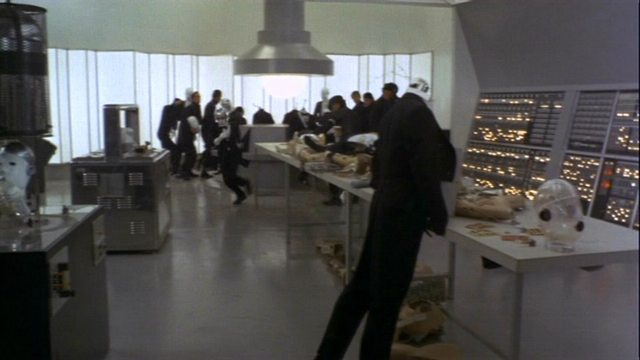
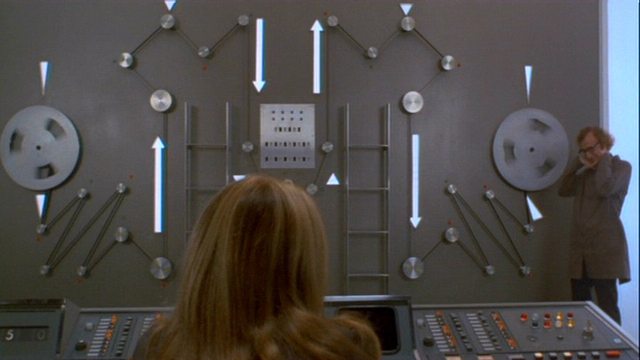
Mike Leuven, who served in the US Air Force in 1982-86. and one of the last ones who found the last working copy of AN / FSQ-7, first noticed the familiar panels in the series of the mid-60s era The Time Tunnel and became interested in what other films this lamp monster played. In the Time Tunnel, the Q7 plays the role of a secret state time machine project built under the Arizona desert.

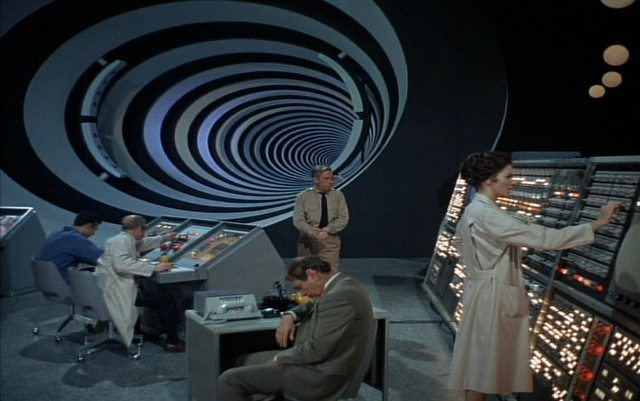
The appearance of the computer AN / FSQ-7 would be most logical in the film “Doctor Strangelove, or How I stopped being afraid and fell in love with the bomb” - then he would fulfill his direct air defense function, but the old IBM 7090/94 is used in the Stanley Kubrick comedy .
One of the most popular works in which Q7 appeared is the 1996 Independence Day. Although the last computer in the series was stopped 13 years before, in the film he plays the role of a modern command center.
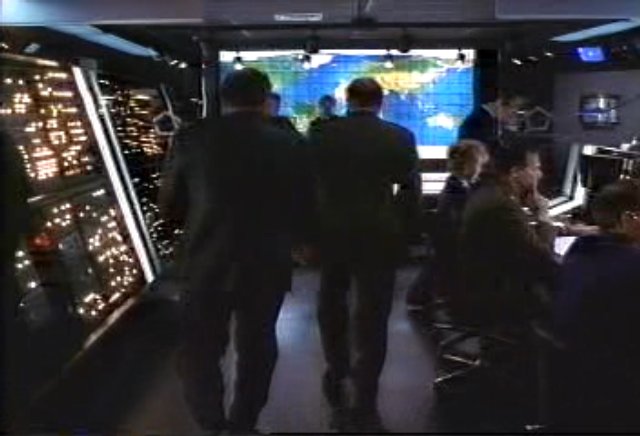
The 1983 film “War Games” (WarGames) is full of many blinking panels, screens (which the protagonist alone is defense computer WOPR), but Q7 has nothing in common with them, it appears in the form of control panels of the main magnetic drum and circuit indicators only in an archival video with Professor Falken.
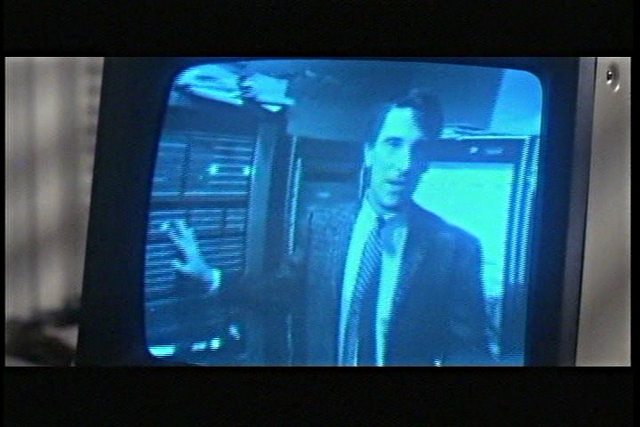
AN / FSQ-7 - and still a frequent guest of the screen, for example, he was spotted on the Lost series (“Lost”). He appears as a whole group (from left to right) of power panels, manual checking of drums and radar panels.

How did the equipment from a secret defense computer so quickly hit the frame of mass cinema? The most famous are the two firms that possessed panels and parts of decommissioned Q7: Vectrex Corporation and Woody's Electrical Props . The first company from Santa Monica rented computer parts for, for example, the “Starstar Galactica” (Battlestar Galactica), but in the 80s they went out of business and sold the rest of the equipment. Some of the panels were purchased by private individuals .
Woody 's Electric Props provided Q7 parts for films about Austin Pauris, WarGames (War Games), Apollo 13 (Apollo 13) and the Lost TV series (Survivor). At the beginning of the 60s, Twentieth Century Fox acquired the decommissioned AN / FSQ-7, the panels of which were later purchased by Woody’s props specialist. Since that time, some of the lamps in the panels have been replaced, and Mike Leuven leads photos of Woody's props .
Based on the report's Introduction to AN / FSQ-7 Combat Direction Central and AN / FS-8 Combat Control Central, IBM-SAGE-Computer , plyojump.com , to the memoirs of Pete Carculius, Q-7 technique in 1967—69 , Wired .com , Mike Leuven’s list of IBM AN / FSQ-7 computer appearances in media and Starring the Computer’s website list of IBM AN / FSQ-7 computer appearances in media .
Source: https://habr.com/ru/post/174845/
All Articles